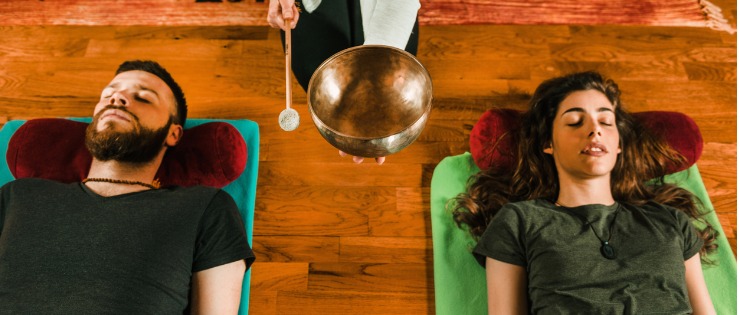
If you’ve ever taken a deep dive into Taylor Swift’s back catalogue, you’ll be familiar with the power of music to heal. Yet the art of sound healing originates millennia before Swift released Cruel Summer, Shake It Off, or even All Too Well (10 Minute Version), and has seen a resurgence in popularity lately due to its mental health benefits.
Sound healing itself is an ancient practice that uses the power of sound vibrations to balance and restore the body’s natural frequency. It is a holistic approach to healing that involves the use of various sound tools such as singing bowls, gongs, chimes, and drums to induce a state of deep relaxation and promote physical, emotional, and spiritual well-being.
The principle behind sound healing is rooted in the belief that everything in the universe vibrates at a certain frequency… bear with me here. Each organ, bone, and cell in the body also has its own unique vibrational frequency. As lore states, when the body is in a state of balance, all these frequencies are in harmony, and the body functions optimally. However, when there is a disruption in the body’s natural frequency, it can result in physical, emotional, or spiritual imbalances, leading to various health problems.
Essentially it all works by using specific sound frequencies to restore the body’s natural frequency and promote healing. During a session, a sound healing practitioner uses various sound tools to create a harmonic resonance that can penetrate deep into the body and activate the body’s natural healing mechanism. The sound waves generated by these tools are powerful enough to shift the energy patterns in the body and promote a state of relaxation and inner peace.
One of the most popular sound tools used in sound healing, and certainly the one that makes the front of the pamphlets, is the singing bowl. Singing bowls are made of metal and produce a deep, resonant sound when struck or played with a mallet. The vibrations produced by the singing bowl can help to release tension, reduce stress, and promote a sense of well-being. They are often used in meditation practices to induce a state of deep relaxation and enhance spiritual awareness.
Gongs are another popular sound tool used in sound healing. They produce a deep, reverberating sound that can fill a room with enough energy to promote healing. The sound waves generated by gongs are believed to help release blockages in the body’s energy pathways, improve circulation, and promote a state of calmness and relaxation.
Chimes and bells are also used in sound healing to create a gentle and soothing sound that can promote relaxation and inner peace. The delicate sound produced by these tools can help to clear the mind of negative thoughts and emotions, allowing the body to enter a state of deep relaxation and healing.
Finally, drums are another popular sound tool used in sound healing. They produce a rhythmic and steady beat that can help to synchronise the brainwaves and promote a state of deep relaxation. The sound waves generated by drums can also help to release tension and promote a sense of well-being.
When it comes to scientific backing, the practice has been verified, resoundingly, thanks to a study published in the Journal of Evidence-Based Integrative Medicine. In the study, sound healing has been credited with providing an effective treatment for a wide range of health problems, including anxiety, depression, chronic pain, and insomnia. It can also help to improve the immune system, reduce inflammation, and promote the body’s natural healing mechanism.
Keen to get involved? Consider finding a certified practitioner in your area or take your own ‘sound bath’ on Spotify starting with the below track for calming… in between Taylor Swift bangers of course.
https://open.spotify.com/track/4MuuGvZf7vNEJyMxDjvL31?si=25d479a0caf64e08